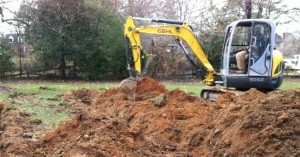 We live in a 45 year-old house just beyond the county utility lines, so we’ve got a septic tank out back, and a few months ago, the system collapsed. Here’s a December 2014 shot of guys repairing the drain fields. In the process, they plowed through a bed of lilies—one I’d planted in 1990 with ten bulbs or so. Over the years, those lilies multiplied a hundred fold, but the only photo I could find was one with our golden retriever, taken when the dogwood and red bud were in bloom (two months before the lilies opened). By June when the lilies blossomed, they’d stretch so tall they’d dwarf the dog, and she’d nap smack-dab in the middle of them.
We live in a 45 year-old house just beyond the county utility lines, so we’ve got a septic tank out back, and a few months ago, the system collapsed. Here’s a December 2014 shot of guys repairing the drain fields. In the process, they plowed through a bed of lilies—one I’d planted in 1990 with ten bulbs or so. Over the years, those lilies multiplied a hundred fold, but the only photo I could find was one with our golden retriever, taken when the dogwood and red bud were in bloom (two months before the lilies opened). By June when the lilies blossomed, they’d stretch so tall they’d dwarf the dog, and she’d nap smack-dab in the middle of them.
In December when the guys filled in the trenches, well… let’s just say that this spring our yard is coming up lilies. Over the past few weeks, I’ve moved a bunch out of the lawnmower’s path, and although I keep watching for more to sprout through the mud, it might be that at this point, I’ve found all that are destined to survive.
 I considered returning the survivors to the 1990 location, but when I realized that I could put them wherever I wanted, I got excited. I can change the landscape if I want to. Yes! I can change.
I considered returning the survivors to the 1990 location, but when I realized that I could put them wherever I wanted, I got excited. I can change the landscape if I want to. Yes! I can change.
As I began to draft this blog post, it hit me that progress on my manuscript feels a lot like moving lilies. I’m landscaping a story. I’ve taken a bulldozer to many chapters, overhauling some, burying others. A few gems—a phrase here, a paragraph there—stuck in otherwise muddy scenes have managed to sprout, getting my attention by waving little green shoots in the slanted spring sunlight, and I’ve resurrected them, leaving the mud behind.
Soon we’ll spread topsoil and reseed the backyard, and by next year we’ll have forgotten the scattered lilies that failed to surface. Soon the revised novel will be ready for comments from trusted readers, and they’ll never encounter the story’s early but unnecessary characters, its deleted scenes, its buried bulbs. The new landscape will feature only the strongest bits, the most compelling.
 Of course, the possibility for change existed before the backhoe destroyed the lily bed, but change doesn’t come easy. A complete overhaul is a lot of work. It’s hard to envision… hard to require that much from a landscaper, or from yourself. The lilies bloomed each year. The story moved along, and I thought it would work with four alternating points of view.
Of course, the possibility for change existed before the backhoe destroyed the lily bed, but change doesn’t come easy. A complete overhaul is a lot of work. It’s hard to envision… hard to require that much from a landscaper, or from yourself. The lilies bloomed each year. The story moved along, and I thought it would work with four alternating points of view.
But once I stood back and mulled over the whole yard, I decided to plant the lilies in a new location. In the novel, I’ve deleted two points of view and re-envisioned the emotional arc for the two main characters that remain. If the new version flourishes in the way I hope the relocated lily bed will, perhaps it will captivate readers and their numbers will multiply a hundred fold, and every June when bees and butterflies swarm around our yellow-orange blossoms, I will smile.
Ahhhh… the dreams of a writer emerging from a particularly cold winter…

I hope the lilies thrive! Best of luck again with your manuscript, and your flower bed. 🙂
Thank you! Sometimes revision feels brutal like bulldozing a bed of lilies, but yes… I think the lilies will thrive, and so will this novel…!
Growing on top of a collapsed sewer line probably gave your lilies a strong start and contributed to their survival elsewhere. All that lovely nitrogen. And there has to be a metaphor for writing somewhere in this.
Haha, Lyn. Yes! The whole septic system as metaphor… hmmm…
A very apt metaphor! I feel like I’m moving lilies around as I draft!
Lovely and inspiring post!
Yes, Linda! And thank you, Robin. Right now when I walk through our backyard, I see a sad and sorry mess, but because I know it’ll look fine a year from now, I’m hope-filled. And the hope keeps me slogging through this manuscript!